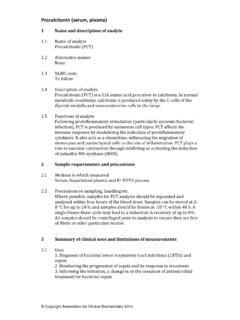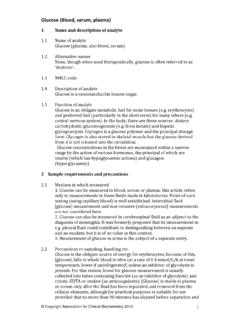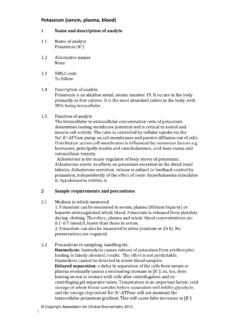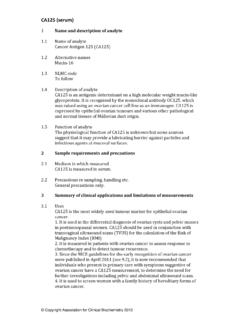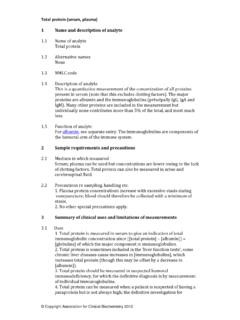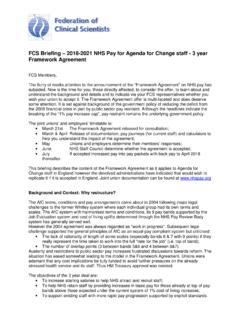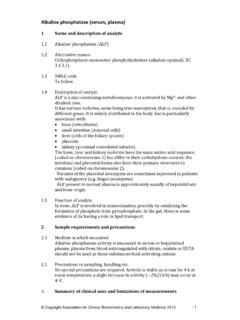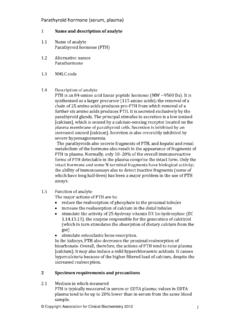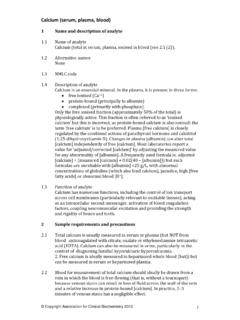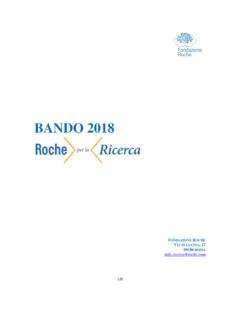Transcription of Fructosamine (plasma, serum)
1 Copyright Association for Clinical Biochemistry 2012 Fructosamine (plasma, serum) 1 Name and description of analyte Name of analyte Fructosamine Alternative names None, although glycated proteins are related NLMC code To follow Description of analyte Fructosamine is the name given to ketoamine products formed from the non-enzymatic attachment of a carbohydrate to a protein. The reaction between glucose and plasma proteins forms unstable Schiff bases that are converted to stable ketoamine products ( Fructosamine ). In the context of Fructosamine as a test analyte, the process usually refers to the attachment of glucose to plasma proteins. Function of analyte Fructosamine has no known biological function. 2 Sample requirements and precautions Medium in which measured Serum or plasma Precautions re sampling, handling etc.
2 EDTA or lithium heparin plasma or serum samples should be separated within 3 h. Samples are stable at 2 8 C for 2 weeks and at -20 C for 5 weeks. When Fructosamine measurements are used for monitoring, the same sample type should be used throughout (see section ). 3 Summary of clinical uses and limitations of measurements Uses Plasma [ Fructosamine ] is proportional to the mean blood [glucose] of an individual over the previous 1 3 weeks and has been advocated as a tool for the assessment of glycaemic control in patients with diabetes mellitus. As the mean half-life of plasma proteins is approximately 2 3 weeks, Fructosamine provides a shorter term representation of glycaemic control than HbA1c. There are limited and conflicting data in the literature on both the correlation with HbA1c and with clinical outcomes in diabetes.
3 No major clinical trial that focuses on developing the complications of diabetes as a clinical outcome has compared Fructosamine with HbA1c. It has been advocated as an alternative to HbA1c measurement when the latter is likely to be an inappropriate or inaccurate measurement of mean [glucose] in an individual ( in a patient with a short red cell life span, see ). NICE Guidelines indicate that that Fructosamine should not be used as a replacement for HbA1c in the general diabetic population. Limitations Copyright Association for Clinical Biochemistry 2012 Measurements may be invalid when there are significant abnormalities of plasma protein concentrations in nephrotic syndrome, liver cirrhosis, paraproteinaemias ,during an acute phase response and in untreated thyroid disease 4 Analytical considerations Analytical methods The most frequently used commercially available assays are colorimetric nitroblue tetrazolium (NBT) assay and enzymatic assays.
4 The majority of UK laboratories using the UK NEQAS scheme employ the NBT assay, 1. Colorimetric method using nitrobluetetrazolium (NBT) Serum is added to carbonate buffer containing NBT (pH , 37 C). The assay is based on the reducing properties of Fructosamine under alkaline conditions. Fructosamine reduces NBT and the change in absorbance is measured at 530 nm. 2. Colorimetric method using 2-thiobarbituric acid (TBA) Serum is heated with oxalic or acetic acid at 100 oC for 18 24 h to form 5-hydroxymethylfurfuraldehyde (HMF); protein is precipitated with trichloroacetic acid; HMF in the supernatant is heated wtih TBA at 40 C for 30 min to form a derivative measured at 443 nm. 3. Colorimetric method using phenylhydrazine Phenylhydrazine reacts with Fructosamine to form a phenylhydrazone adduct with absorption at 350 nm.
5 The absorbance is directly proportional to [ Fructosamine ]. 4. Enzymatic assay The reactions are: Glycated protein (proteinase K, EC ) glycated protein fragments Glycated protein fragments (ketoamine oxidase, EC not assigned) amino acids + H202 H202 + chromogens (horseradish peroxidase, EC ) colour + H20 5. Other methods have been developed but are not commercially available. Reference method High pressure liquid chromatography (HPLC) Fructosamine is hydrolysed with 6M HCl at 95 C for 18 h producing lysine (50%), furosine (30%) and pyridosine (10%). Furosine is quantified by HPLC using a reverse phase column with UV detection at 254 nm and 280 nm. Reference materials An approved reference material is not currently available for Fructosamine measurement. The Randox Laboratories Ltd enzymatic method uses a calibrator assigned relative to human serum glycated with 14C-glucose.
6 Copyright Association for Clinical Biochemistry 2012 Interfering substances The NBT method has been widely automated but interferences vary between manufacturer s methods. The manufacturer s test insert should be consulted for more details, but the following are widely reported to interfere with this assay. Note that the Roche second generation assay is less prone to some interferences than its predecessor. 1. EDTA and heparin plasma samples give lower Fructosamine results than serum samples in the NBT colorimetric assay. 2. Urate and glutathione produce artificially high results in the NBT assay. 3. Vitamin C >227 mol/L interfere significantly with the NBT colorimetric assay. 4. Cysteine, methyldopa, dobesilate calcium and oxytetracycline can cause artificially low Fructosamine results (all assays).
7 5. Bilirubin > mol/L has been shown to cause falsely elevated Fructosamine results (all assays). 6. Haemolysis can also cause falsely low results (all assays). Sources of error 1. Colorimetric assays are affected by changes in ambient temperature. 2. There is inconsistent evidence on the magnitude of any effect that abnormalities in plasma albumin or total protein concentrations have on Fructosamine values although marked abnormalities are generally regarded as a potential source of error. 3. EDTA plasma samples have been demonstrated to give a 6% negative bias relative to serum samples; for this reason, the same sample type should always be used for monitoring individual patients. 5 Reference intervals and variance Reference interval (adults) For adults without diabetes, a reference range of 205 285 mol/L has been determined in 555 apparently healthy subjects using the NBT method.
8 A range of 122 236 mol/L has been established in 466 non-diabetic adults aged 20 60 y for the enzymatic method. In patients with diabetes, specific targets are used and [ Fructosamine ] are monitored over time to assess changes. Reference intervals (others) Pregnancy: in a study of 516 non-diabetic pregnant women, a significant reduction in [ Fructosamine ] was recorded in successive trimesters of pregnancy; the differences were significant between Caucasian and Asian women: Fructosamine ( mol/L) Trimester 1 Trimester 2 Trimester 3 Caucasians n = 100 n = 100 n = 67 Range 188 256 176 252 160 219 Asian n = 59 n = 100 n = 90 Range 180 247 176 240 171 221 Extent of variation Inter-individual CV: (NBT colorimetric method, based on data corrected for serum albumin of 40 g/L Copyright Association for Clinical Biochemistry 2012 Intraindividual CV: (as ) Index of individuality: CV of method Inter-assay % CV from assay manufacturer: Roche Cobas Integra NBT colorimetric assay: (181 mol/L).)
9 (450 mol/L) Randox enzymatic assay: (174 mol/L); (440 mol/L) Critical difference Roche Cobas Integra NBT colorimetric method: Randox enzymatic assay: Sources of variation 1. Because serum [ Fructosamine ] is proportional to blood [glucose], any changes in glycaemic control over a period of 2 3 weeks, whether due to changes in lifestyle or treatment, will influence Fructosamine results. 2. Large increases or decreases in plasma [protein] will also result in variability in Fructosamine results and give an inaccurate impression of glcaemic control. 6 Clinical uses of measurement and interpretation of results Uses and interpretation Fructosamine monitoring may be useful when it is important to monitor changes in glycaemic control over a shorter term, in pregnancy. The test can also be used as an alternative marker of glycaemia where HbA1c may be less reliable as a measure of glycaemic control, for example as is the case with some assays in patients with haemoglobinopathies, silent haemoglobin variants or anaemia.
10 However, a glycated haemoglobin method based on affinity chromatography (Trinity (Primus) HPLC) is minimally affected by most variant haemoglobins. The method has the advantage that it provides a measurement that is calibrated to produce results that are equivalent to HbA1c in both units and numerical value. Confounding factors Fructosamine is not a suitable measure of glycaemic control in patients with rapidly changing plasma protein concentrations or when albumin turnover is increased in hyperthyroidism 7 Causes of abnormal results High values Causes: diabetes mellitus interferences (see section ). Investigation Not applicable. Fructosamine should only be measured as an index of glycaemic control in patients with diabetes. Low values Causes: long periods of hypoglycaemia assay interference from certain drugs or haemolysis (see section ); use of EDTA plasma protein losing states nephrotic syndrome, malnutrition, burns.
